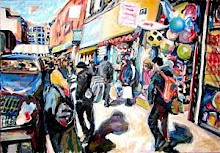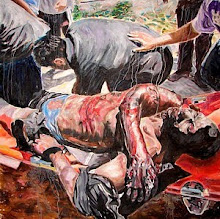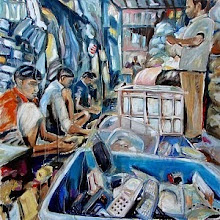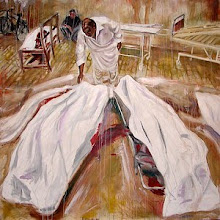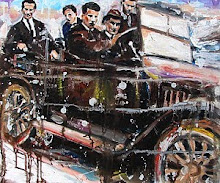'Inde etiam habitus nostri honor et frequens toga; paulatimque discessum ad delenimenta vitiorum, porticus et balinea et convivorum elegantiam. Idque apud imperitos humanitas vocabatur, cum pars servitutis esset'
('They adopted our dressing fashion, and begun wearing the togas; little by little they were drawn to touches such as colonnades, baths, and elegant talks. Because they didn't know better, they called it 'civilization,' when it was part of their slavery')
Tacitus, Agricola
Introduction
The general problem of culture today is its ability to facilitate and support negative aspects of society through encouraging escapism, diversion and ignorance regarding many important issues of contemporary life, such as economic crises, repressive legislation, poverty, and climate chaos. Or worse still, the use of culture to promote elite views of society regarding power and money, as well as imperialist agendas through negative depictions of a targeted ethnic group or country.
In this, some would call a neo-feudalist age, we see echoes of an earlier feudalism with its abuse of power and wealth that the philosophers of the Enlightenment tried to deal with and rectify. The Enlightenment was an intellectual and philosophical movement that dominated the world of ideas in Europe during the 17th and 18th centuries.
It was led by philosophers such as Cesare Beccaria, Denis Diderot, David Hume, Immanuel Kant, Gottfried Wilhelm Leibniz, John Locke, Montesquieu, Jean-Jacques Rousseau, Adam Smith, Hugo Grotius, Baruch Spinoza, and Voltaire. Their concerns about injustice, intolerance and autocracy led to the introduction of democratic values and institutions, and the creation of modern, liberal democracies.

A painting of the 1840 Anti-Slavery Conference. The Anti-Slavery Society Convention, 1840, by Benjamin Robert Haydon (died 1846), given to the National Portrait Gallery, London in 1880 by the British and Foreign Anti-Slavery Society. Oil on canvas, 1841. 117 in. x 151 in. (2972 mm x 3836 mm). This monumental painting records the 1840 convention of the British and Foreign Anti-Slavery Society which was established to promote worldwide abolition.
However, a new movement in the arts and literature arose in the late 18th century, Romanticism, which emphasized inspiration, subjectivity, and the primacy of the individual. Romanticism was a reaction to the Industrial Revolution, aristocratic society and politics, and the scientific rationalization of nature. Romanticism became the basis of many subsequent cultural movements whose common feature has been anti-science and individualism.
The Romanticist influence can be seen in ‘mainstream’ mass culture and high culture in terms of its emphasis on formal experimentation or emotions over sociopolitical content. Romanticist reaction stressed “sensibility” or feeling, and tended towards looking inwards. It was a movement whose ideas have come to dominate much of culture today.
Weighing scales, planets, and fractals
Romanticism is portrayed as having left and right aspects. If we picture a weighing scale with opposing ideas, for example, we can have the radical opposition to fascism (Romanticist Expressionism) on one side and the radical right of National Socialism on the other side. However, what if this weighing scale was on one side of an even bigger scale? On the other side of that bigger scale would be Enlightenment ideas.
We rarely get to see the Enlightenment side of the larger scales. We live in a society where we are generally presented with the small scales two-sides-to-everything (the bi-party system, good Nazis [only following orders] v the bad Nazis [gave the orders], this 'good' person v that 'bad' person, good cop v bad cop) but the reality is that they are usually different sides of the same coin. Similarly, on the smaller scale, the left and right aspects of Romanticist ideas are also two sides of the same coin, because what they both have in common is their rejection of science and reason.
Yet, on the big scales, the Enlightenment side we find progressive politics, the left opposition who were the first to be put into the concentration camps in the 1930s, the community workers, writers, and activists who work diligently today for change in the background are all squeezed out of the large, dominant media-controlled picture.
The problem with this skewed picture is that understanding what is going on becomes as difficult to ascertain as the movements of the planets were to the ancients. Seeming to go in all sorts of strange directions, the ancient Greeks called the planets 'planeta' or 'wanderers'. The movements of the planets were perplexing in a geocentric (earth-centered) universe. It was only with the application of modern science, putting the sun at the center of a solar system, that the odd movements of the planets suddenly fell into place and made sense. We have the same experience of 'revelation' or understanding when science is applied to many different difficult problems in various aspects of history, philosophy and society itself.

The word 'science' comes from the Latin word 'scientia' meaning 'knowledge' and is a systematic exploration that allows us to develop knowledge in the form of testable explanations and predictions about the universe. The development of science has allowed us to determine what is truth and what is falsehood. Truth is defined as the property of being in accord with fact or reality and the application of science allows us to verify truth in a provable way.
In this sense truth is like a fractal. Fractals are geometrical shapes that have a certain definite appearance. When we magnify a fractal we see the same shape again. No matter how much we magnify the shape, the same geometrical patterns appear infinitely. Truth is similar to a fractal in that whether the truth of something is held by one person, a group of people, a community or a nation its essence remains the same on a micro or macro level.
'Fractals appear the same at different levels, as illustrated in successive magnifications of the Mandelbrot set. Fractals exhibit similar patterns at increasingly small scales called self-similarity, also known as expanding symmetry or unfolding symmetry.'
The heliocentric view of the universe remains true even if only one person believes or many believe, even in the face of powerful forces. For example, Galileo's championing of heliocentrism led him to be investigated by the Roman Inquisition in 1615, where he was found guilty of heresy and spent the rest of his life under house arrest. The truth eventually came out and Galileo was pardoned by the Roman Catholic church (359 years later).
Contradictions and falsehoods
It has often been said that the truth will set you free. We live in a society of contradictions and falsehoods where lies, cheating and deception contradict reality. However, many refuse to see the truths of modern society, while others are actively involved in creating the deceptions that maintain the status quo. We know that people are 'unfree' and we accept many different levels of this condition: captivity, imprisonment, suppression, dependency, restrictions, enslavement, oppression.
We may even see this condition as applying to others and not to ourselves. But if we examine closely and truthfully our own position in the societal hierarchy we may recognize our own powerlessness: the contradiction between our view of ourselves and the reality of our situation. Although we vote and we recognize the social contract by rendering taxes to the state, the fact is that very little of substance changes and generally things seem to get worse.
As I have written elsewhere, the fact is that we are triply exploited: we are taxed on wages, alienated from wealth created (profits), and we pay interest on the money borrowed from the wealthy to pay for the capital and current expenditure needed for the maintenance of society and fill in the gap
created
by the wealthy in the first place.
How is this system of exploitation maintained? Aside from the obvious threat of imprisonment for nonpayment of taxes, and the existence of police and army to enforce the laws of the state: the most influential, and sometimes most subtle tool, is through culture.
The culture of slavery
Culture has a long history of use and abuse, from the bread and circuses of Roman times to the social media of today.
In modern society mass culture helps to maintain this system of exploitation and keeps people in general from questioning their position in the societal hierarchy. The middle classes are lulled into thinking they are free because of better wages making for an easier life, while the working class work ever harder to achieve the benefits of the middle class: higher education, higher status, higher wages. (It has been suggested that the middle class are essentially 'working class people with huge debts' e.g. large mortgages.)
However, in general, people work in a globalized system of exploitation in states that support and maintain it thus making wage slaves of the 99 per cent.

Slaves in chains during the period of Roman rule at Smyrna (present-day İzmir), 200 CE.
The traditional definition of slavery is 'someone forbidden to quit their service for another person and is treated like property.' Modern slavery takes on different forms such as human trafficking, debt bondage, and forced labour:
"Experts have calculated that roughly 13 million people were captured and sold as slaves between the 15th and 19th centuries; today, an estimated 40.3 million people – more than three times the figure during the transatlantic slave trade – are living in some form of modern slavery, according to the latest figures published by the UN’s International Labour Organization (ILO) and the Walk Free Foundation. Women and girls comprise 71% of all modern slavery victims. Children make up 25% and account for 10 million of all the slaves worldwide."
While this may apply to the most extreme cases in modern society, the majority of workers have no control over the wealth they produce:
"one of the defining features of the employment relationship in all capitalist countries is that the worker’s will is, by law, “subordinate” to the employers. The employer has the right, within broad bounds, to define the nature of the task, who performs it, and how. This shows up in all kinds of surveillance, control, and submission — also known as maximizing productivity and extracting profit."
The investors and the shareholders benefit the most, while the employees receive wages of varying levels according to the demand for their particular skillset.
We are encouraged to accept this way of life and there are plenty of different state methods to make sure that we do. However, culture is an important tool of soft power, in particular, mass culture.
The role of mass culture is absolutely essential for the creation, maintenance, and perpetuation of a broad acceptance of the ever-changing forms of technological 'progress' and geopolitical shifts in modern capitalist societies, particularly as the global financial crisis (corporate and national debt) deepens.
Culture on three levels
To do this, modern mass culture operates on three different levels. The first level is creating acceptance through diversion and escapism and turning people into passive consumers. Secondly, through the overt representation of elite ideology. Thirdly, and more controversially, through covert manipulation of mass culture to benefit the agenda of elites.
In the first case, consumption becomes inseparable from the ideas of enjoyment and fun. Earlier twentieth century theorists of the Frankfurt School saw consumers as essentially passive but later theoreticians such as Baudrillard saw consumption as an unconscious social conditioning, consuming culture to achieve social mobility by showing awareness of the latest trends in mass culture.
Secondly, overt representation of elite ideology is evident in mass culture that glorifies the upper classes and promotes racism and militarist imperialism. In particular, mass culture depicting historical and contemporary events can be portrayed from an elite perspective.
Thirdly, conscious manipulation of the masses using psychological means, and more controversially, predictive programming. In the 1930s Edward Bernays was a pioneer in the public relations industry using psychology and other social sciences to design public persuasion campaigns. Bernays wrote: "If we understand the mechanism and motives of the group mind, is it not possible to control and regiment the masses according to our will without their knowing about it? The recent practice of propaganda has proved that it is possible, at least up to a certain point and within certain limits."

'For Adorno and Horkheimer, the culture industry creates false needs to keep us purchasing products we do not actually need by manipulating our psychological impulses and desires.'
Another form of mass manipulation is the concept of predictive programming. Predictive Programming is the theory "that the government or other higher-ups are using fictional movies or books as a mass mind control tool to make the population more accepting of planned future events." It is by its nature hard to prove yet the many extraordinary coincidences between events depicted in mass culture and later actual events is, at the very least, disconcerting. For example, the film The Manchurian Candidate depicting the son of a prominent U.S. political family who is brainwashed into being an unwitting assassin for a Communist conspiracy, was released in 1962, a year before the assassination of J F Kennedy in 1963 by Lee Harvey Oswald, an emotionally disturbed 'communist sympathizer' who declared his innocence and believed he was being used as a 'patsy'.
Thus, these three levels allow elites to control how the past, the present, and the future is depicted in mass culture, according to national and geopolitical agendas.
Cultural producers
In their defense, the role of cultural producers has never been easy, and the more money or support that is needed for a cultural project, the harder it is to maintain an independent position.
While with modern production methods and technology it is easier to produce books, films and music independently of the major producers and distributors, in the past elite pressure, censorship, and imprisonment were common.
Pushkin, for example, in his Ode to Liberty, exclaimed with indignation:
"Unhappy nation! Everywhere
Men suffer under whips and chains,
And over all injustice reigns,
And haughty peers abuse their power
And sombre prejudice prevails."
However, later during the time of Nicholas I, he changed and 'adopted the theory of art for art's sake':
"According to the touching and very widespread legend, in 1826 Nicholas I graciously “forgave” Pushkin the political “errors of his youth,” and even became his magnanimous patron. But this is far from the truth. Nicholas and his right-hand man in affairs of this kind, Chief of Police Benkendorf, “forgave” Pushkin nothing, and their “patronage” took the form of a long series of intolerable humiliations. Benkendorf reported to Nicholas in 1827: “After his interview with me, Pushkin spoke enthusiastically of Your Majesty in the English Club, and compelled his fellow diners to drink Your Majesty’s health. He is a regular ne’er-do-well, but if we succeed in directing his pen and his tongue, it will be a good thing.” The last words in this quotation reveal the secret of the “patronage” accorded to Pushkin. They wanted to make him a minstrel of the existing order of things. Nicholas I and Benkendorf had made it their aim to direct Pushkin’s unruly muse into the channels of official morality."
Pushkin’s contemporaries, the French Romanticists, were also, with few exceptions, ardent believers in art for art’s sake, the idea of the absolute autonomy of art with no other purpose than itself.
In the twentieth century, Ars Gratia Artis (Latin: Art for Art’s Sake) would become the motto for the American media company Metro-Goldwyn-Mayer, to designate art that is independent of political and social pressures.
Of course, while some believe that art should not be politicized, others think that if art was not a social endeavor then it would be used as a commercial item only available to the rich, e.g. a profitable escapist product while simultaneously maintaining and promoting a conservative mindset.

'During
the Cold War period, films were an important factor in the persuasion
of the masses. They would be used in various ways, to present the ideal
image of their country and to distinguish a national enemy, to name a
few.'
However, any thoughts of art as a progressive tool were soon quashed by the HUAC (House Un-American Activities Committee) in the USA, a body which was set up in 1938 to investigate alleged disloyalty and subversive activities on the part of private citizens, public employees, and any organizations with left wing sympathies.
Dialectic of Enlightenment
Not long after, a theoretical analysis of consumerist mass culture was published in a book by Theodor Adorno (1903–1969) and Max Horkheimer (1895–1973) in 1947 entitled Dialectic of Enlightenment in which they coined the term the Culture Industry. For Adorno and Horkheimer "the mass-media entertainment industry and commercialized popular culture, which they saw as primarily concerned with producing not only symbolic goods but also needs and consumers, serving the ideological function of diversion, and thus depoliticizing the working class."
They believed that the production of culture had become like a "a factory producing standardized cultural goods — films, radio programmes, magazines, etc.— that are used to manipulate mass society into passivity."

Thomas Hart Benton, Hollywood 1937-38 oil on canvas; 56x84 in. (142.2x213.4 cm)
More significantly, Adorno and Horkheimer also believed that the scientific thinking the Enlightenment philosophers had developed "led to the development of technologically sophisticated but oppressive and inhumane modes of governance."
Adorno and Horkheimer believed that because the rationalization of society had ultimately led to Fascism, science and rationalism provided little optimism for future progress and human freedom.
However, this view of the history of science and its relationship with human emancipation is, according to Jeffrey Herf in '"Dialectic of Enlightenment" Reconsidered', one that ignores many progressive movements and changes brought about by Enlightenment ideas, and that Horkheimer and Adorno's view of modern society and politics simply reduced modernity to technology, science, and bureaucracy. Herf outlines many of the events, institutions, laws, rights, treatments and other human benefits that Adorno and Horkheimer (and others) had ignored:
"In Weber's sociology, Heidegger's philosophical ruminations, or Dialectic of Enlightenment, the panoply of ideas and events associated with the 1688 revolution in Britain, the moderate wing of the French Revolution, and the ideas and institutions that emerged from the American Revolution, and then from the victory of the North in the American Civil War, are simply absent. As a result of this paucity of historical specificity, Horkheimer and Adorno's view of modernity during World War II was a very German caricature that did not include ideas about the extension of citizenship, British antislavery, American abolitionism, feminism in Europe and the United States, and the rule of law. Theirs was modernity without liberal democratic ideas and institutions, the rule of law, and the freedom of speech, of assembly, of the press, and of religion or unbelief. [...] Dialectic of Enlightenment presented modern science as primarily an exercise in the domination of nature and of human beings. Theirs was a view of the history of the scientific revolution that left out Galileo's challenge to religious authoritarianism and Francis Bacon's liberating restatement of the role of evidence in resolving contentious issues. From reading Horkheimer and Adorno — as well as Heidegger and Baumann — one would conclude that modern science was first and foremost a source of control, and would have no idea of how modern medicine, unthinkable without the Enlightenment and the scientific revolution, had come into existence." [1]
Thus, Adorno and Horkheimer's view leaves us with an almost Nietzschian nihilism, that knowledge is impossible, and life is meaningless because to try and improve society will fail and ultimately only increase oppression. Without action, Nietzsche predicted a society of 'the last man', the "apathetic person or society who loses the ability to dream, to strive, and who become unwilling to take risks" and slave morality characterized by pessimism and cynicism. A society which has not only lost its 'will to power' but also its will to revolt.
The culture of resistance
Throughout history, oppression has been met with resistance in many forms such as uprisings, rebellions, and insurrections. 
'Richard II meeting with the rebels of the Peasants' Revolt of 1381.
The Peasants' Revolt, also named Wat Tyler's Rebellion or the Great Rising, was a major uprising across large parts of England in 1381. The revolt had various causes, including the socio-economic and political tensions generated by the Black Death pandemic in the 1340s, the high taxes resulting from the conflict with France during the Hundred Years' War, and instability within the local leadership of London.'
The resistance often starts with strikes, boycotts, and civil disobedience, leading to mass movements of people who ultimately reject the old system of governance and change it for a new system which can be anti-colonial, anti-imperialist or anti-capitalist. The rise of resistance seems to generally develop in three stages, each affecting culture in very different ways. These different stages could be called criticism, substitution and implementation.

Irish Citizen Army group outside Liberty Hall. Group are lined up outside ITGWU HQ under a banner proclaiming "We serve neither King nor Kaiser, but Ireland!". Photo taken in early years of WWI.
Criticism
Resistance often begins as criticism of the policies or nature of government, or the state. This can be aesthetic or intellectual resistance appearing, for example, in various art forms. Critiques can be of an ideological nature, or simply highlight social problems and issues. Resistance can take the form of criticism of officially sanctioned culture through demonstrations and boycotting.
It may also take a violent form, for example, the blowing up of colonial statues in Ireland (see my comprehensive list of statues blown up in my blog post here). The blowing up of Nelson's Pillar in Dublin in 1966 was celebrated subsequently in two different ballads which became immensely popular, an aesthetic critique arising out of a violent 'critique'.
On a formal level resistance can also be 'form-poor' as struggle without help from educated or trained professionals is left to amateurs.
Substitution
Gradually, a new ideology, a different reading of history, a new set of artists and writers produce culture which eventually substitutes the old culture with a new culture as the movement gathers momentum.
The less costly forms like art, music, ballads, books etc. can become very popular and important elements of the resistance itself. The more expensive cultural forms are difficult to produce in the new culture, e.g., cinema, theatre, opera, TV etc., (unless of course if the format is changed like in community theatre substituting for state theatre). Digital equipment can be vastly cheaper to use for the making of movies for mass viewing assuming that the outlet for presentation, the internet, is not closed off through censorship.
Implementation
The final stage is implementation, whereby popular resistance takes control of the state and is able to implement progressive culture as state policy. This is particularly important for the most costly art forms which also gain access to state finance and auditoriums. It allows movies, for example, to cover ignored themes such as histories of resistance, or to show past events from more radical perspectives than the previous elite mindset and agendas.
These different levels of cultural change: criticism, substitution, and implementation can be a long process or all come together in a short span of time.

The storming of the Bastille, 14 July 1789, during the French Revolution.
I have tried to show in my previous examination of ten different art-forms (see: art, music, theatre, opera, literature, poetry, cinema, architecture, TV, and dance articles) that since the Age of Enlightenment there has been a strong vein of radical ideas relating to social progress. Over the centuries radical culture has looked at the plight of the oppressed using different forms such as naturalism, realism, social realism, and working class socialist realism.
The philosophers of the Enlightenment believed that advancements in science, technology, economic development and social organization would have universal application globally. They also believed in the idea that empirical knowledge should be the basis of society and that with these ideas political and societal change would strengthen civilization itself. While social progressivism, as a political philosophy, is reformist in nature, it also has the potential to snowball into more radical action through discussion around questions as to who runs the state and ownership of the means of production.
The form and content of the culture of resistance has many aspects. Some emphasize change on the community level, developing the skills, community spirit, and artistic sensibilities of the community members whether they be producers, creators or observers. An important element of this strategy for social change is encouraging critical thinking through participation in active dialogue. General themes for discussion have been, for example, gender equality, human rights, the environment and democracy.
The Bash Bush Band musical protesters at Bush's 2nd inauguration, Washington DC.
Others have taken a more radical approach of examining human conflict and its sources. They look at human conflict from a social perspective and see society in terms of conflicting economic classes. By portraying economic classes in conflict they hope to evolve or expand a working class consciousness or at least an understanding of, and empathy with, oppressed groups. Radical artists, writers, composers etc are encouraged to take a scientific approach and work against superstitions and blind practices. As radical cultural producers they try to present the truth and inspire wide-ranging social and political activism.
Future of culture?
Modern resistance, often in digital form on the internet today, is now subject to a creeping censorship as big tech tries to slow down the efficacy of the internet at making widely available different perspectives on many different issues. At the same time, big tech tries to portray technological progress as social progress, and is at the forefront of liberal campaigns for individual rights at the expense of mass movements for collective or group rights. Such group rights allow for organizations to speak for, and negotiate on behalf of trade unions, trade associations, specific ethnic groups, political parties, and nation-states.
However, internet censorship and the gradually increasing power of the state (through police, courts, and prisons) using current and new legislation will be able to continue unabated, that is, unless the slave culture that facilitates it is shaken off and a new culture of resistance is born.
Notes:
[1] Jeffrey Herf, "Dialectic of Enlightenment" Reconsidered Source: New German Critique , FALL 2012, No. 117, Special Issue for Anson Rabinbach (FALL 2012), pp. 81-89 Published by: Duke University Press [p84] Stable URL: https://www.jstor.org/stable/23357065
Caoimhghin Ó Croidheáin is an Irish artist, lecturer and writer. His artwork
consists of paintings based on contemporary geopolitical themes as well
as Irish history and cityscapes of Dublin. His blog of critical writing
based on cinema, art and politics along with research on a database of
Realist and Social Realist art from around the world can be viewed
country by country here. He is a Research Associate of the Centre for Research on Globalization.



